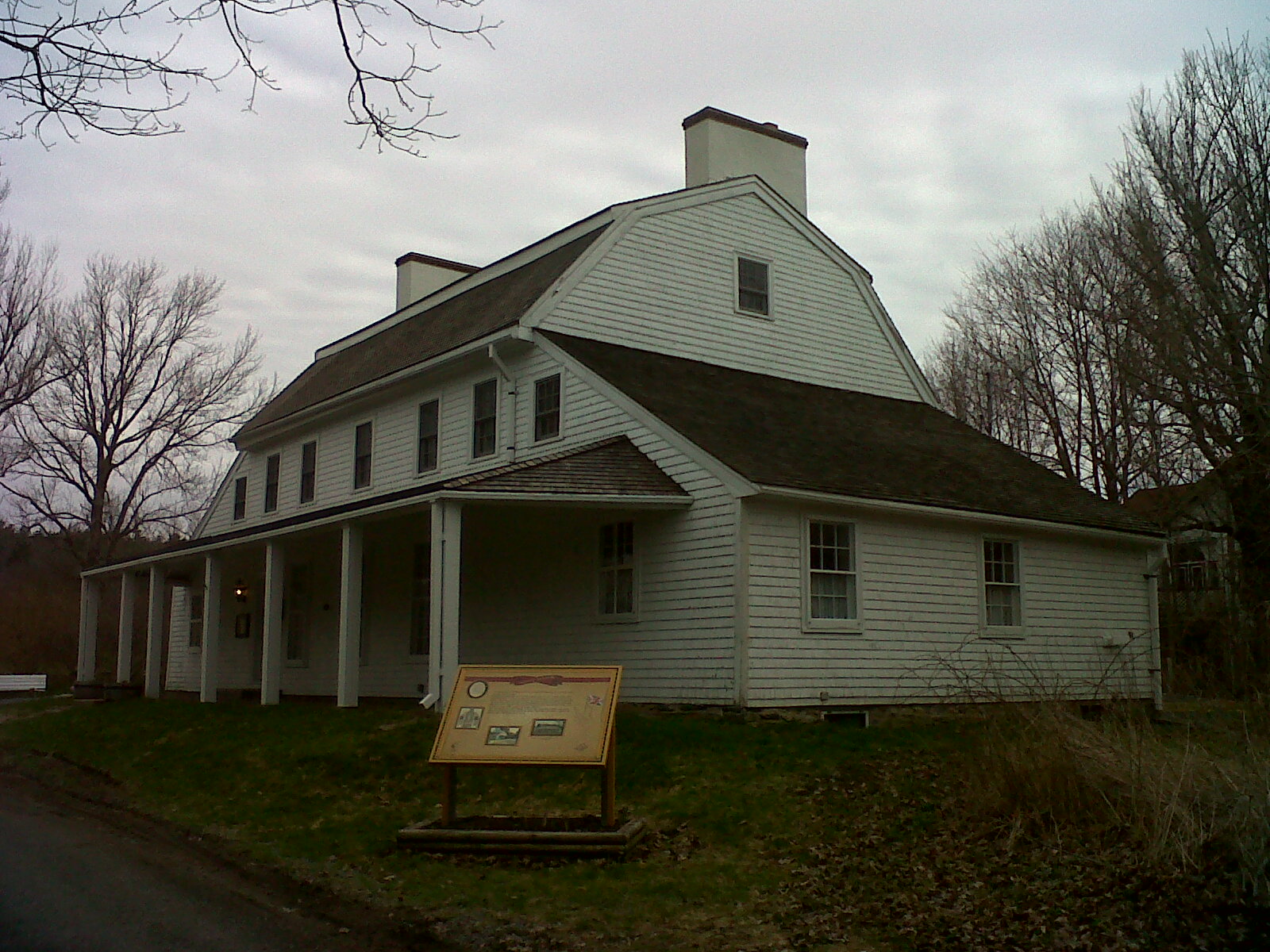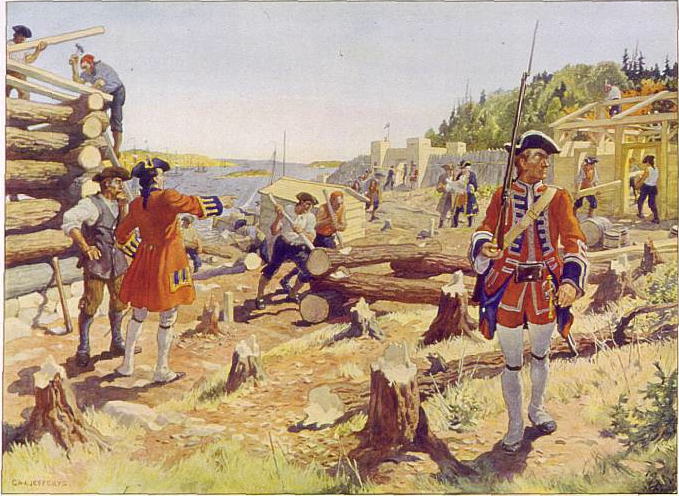|
Raid On Dartmouth (1751)
The Raid on Dartmouth (also referred to as the Dartmouth Massacre) occurred during Father Le Loutre's War on May 13, 1751, when a Miꞌkmaq and Acadian militia from Chignecto, under the command of Acadian Joseph Broussard, raided Dartmouth, Nova Scotia, destroying the town and killing twenty British villagers and wounding British regulars. The town was protected by a blockhouse on Blockhouse Hill (close to the corner of King St. and North St.) with William Clapham's Rangers and British regulars from the 45th Regiment of Foot. This raid was one of seven the Natives and Acadians would conduct against the town during the war. Historical context After the British Conquest of Acadia in 1710, the British laid claim to all of peninsular Acadia, renaming it Nova Scotia. Its population was primarily Catholic French Acadians and the Miꞌkmaq indigenous peoples. The Mi’kmaq numbered about 1000 in total, in Nova Scotia at the time. In response to British settlement, the Miꞌkma ... [...More Info...] [...Related Items...] OR: [Wikipedia] [Google] [Baidu] |
John George Pyke
John George Pyke (4 January 1744 – 3 September 1828) was an English-born merchant and political figure in Nova Scotia. He represented Halifax County from 1779 to 1793 and Halifax Township from 1793 to 1800 and from 1802 to 1818 in the Nova Scotia House of Assembly. He also became head of the Police department. He survived the Raid on Dartmouth (1751) but his father Abraham did not. Background He was the only child of (John) Abraham Pyke and Ann Scrope of Yorkshire. He came to Nova Scotia with his parents on the Alderney in 1750, though he was educated in England. A year after his arrival in Canada his father was killed at Dartmouth by the Mi'kmaqs. His father was buried in an unmarked grave in the Old Burying Ground (Halifax, Nova Scotia). Two months later, John's mother married Richard Wenman. At St. Paul's, Halifax in August, 1772, Pyke married Elizabeth Allan, the daughter of Major William Allan by his wife Isabella, daughter of Sir Eustace Maxwell. Elizabeth Pyke was th ... [...More Info...] [...Related Items...] OR: [Wikipedia] [Google] [Baidu] |
Edward Cornwallis
Edward Cornwallis ( – 14 January 1776) was a British career military officer and was a member of the aristocratic Cornwallis family, who reached the rank of Lieutenant General. After Cornwallis fought in Scotland, putting down the Jacobite rebellion of 1745, he was appointed Groom of the Chamber for King George II (a position he held for the next 17 years). He was then made Governor of Nova Scotia (1749–1752), one of the colonies in North America, and assigned to establish the new town of Halifax, Nova Scotia. Later Cornwallis returned to London, where he was elected as MP for Westminster and married the niece of Robert Walpole, Great Britain's first Prime Minister. Cornwallis was next appointed as Governor of Gibraltar. Cornwallis arrived in Nova Scotia during a period of conflict with the local indigenous Miꞌkmaq peoples of peninsular Nova Scotia. The Mi'kmaq opposed the founding of Halifax and conducted war raids on the colony. Cornwallis responded with the ... [...More Info...] [...Related Items...] OR: [Wikipedia] [Google] [Baidu] |
Fort Sackville (Nova Scotia)
Fort Sackville was a British fort in present-day Bedford, Nova Scotia. It was built during Father Le Loutre's War by British adjacent to present-day Scott Manor House, on a hill overlooking the Sackville River to help prevent French, Acadian and Mi'kmaq attacks on Halifax. The fort consisted of a blockhouse, a guard house, a barracks that housed 50 soldiers, and outbuildings, all encompassed by a palisade. Not far from the fort was a rifle range. The fort was named after George Germain, 1st Viscount Sackville. Historical context Despite the British Conquest of Acadia in 1710, Nova Scotia remained primarily occupied by Catholic Acadians and Mi'kmaq. Father Le Loutre's War began when Edward Cornwallis arrived to establish Halifax with 13 transports on June 21, 1749. The British remained largely in Halifax, having attempted to establish a settlement east of Halifax near present-day Lawrencetown Beach they quickly abandoned the effort due to the threat of Mi'kmaq attacks. Four ... [...More Info...] [...Related Items...] OR: [Wikipedia] [Google] [Baidu] |
Bedford, Nova Scotia
Bedford is a community of the Halifax Regional Municipality, in Nova Scotia, Canada. History The area of Bedford has evidence of Indigenous peoples dating back thousands of years. Petroglyphs are found at Bedford Petroglyphs National Historic Site. The Bedford area is known as Kwipek to the Mi'kmaq First Nation. 18th century On 21 July 1749, Father Le Loutre's War began when Edward Cornwallis arrived to establish Halifax with 13 transports. The British quickly began to build other settlements. To guard against the Acadians, the French, and the Mi'kmaq, British fortifications were erected in Halifax (1749), Bedford ( Fort Sackville) (1749), Dartmouth (1750), Lunenburg (1753) and Lawrencetown (1754). The history of Bedford began when Governor Edward Cornwallis organised his men and began the construction of a road leading to Minas Basin on the Bay of Fundy after establishing the garrison at Halifax. To protect it, he hired John Gorham and his Rangers to erect a fort ... [...More Info...] [...Related Items...] OR: [Wikipedia] [Google] [Baidu] |
Citadel Hill (Fort George)
Citadel Hill is a hill that is a National Historic Site in Halifax, Nova Scotia, Canada. Four fortifications have been constructed on Citadel Hill since the city was founded by the English in 1749, and were referred to as Fort George—but only the third fort (built between 1794 and 1800) was officially named Fort George. According to General Orders of October 20, 1798, it was named after King George III. The first two and the fourth and current fort, were officially called the Halifax Citadel. The last is a concrete star fort. The Citadel is the fortified summit of Citadel Hill. The hill was first fortified in 1749, the year that Edward Cornwallis oversaw the development of the town of Halifax. Those fortifications were successively rebuilt to defend the town from various enemies. Construction and leveling have lowered the summit by ten to twelve metres. While never attacked, the Citadel was long the keystone to defence of the strategically important Halifax Harbour and its ... [...More Info...] [...Related Items...] OR: [Wikipedia] [Google] [Baidu] |
Royal Nova Scotia Historical Society
The Royal Nova Scotia Historical Society is a historical society in Halifax, Nova Scotia that was founded in 1878 and is the second oldest in Canada (The Literary and Historical Society of Quebec is the first.) The Society is a voluntary organization that operates without an office or paid staff. The Society first published the Nova Scotia Historical Quarterly and then the Nova Scotia Historical Review. Eventually the publication was named the Collections of the Royal Nova Scotia Historical Society and now it is known as the Journal of the Royal Nova Scotia Historical Society. Notable members * George Elkana Morton * Harry Piers * Archibald MacMechan * Thomas Beamish Akins Historical Plaques Image:Valley 244.jpg, Sir William Fenwick Williams, Annapolis Royal, Nova Scotia File:SirJohnMoorePlaqueHalifaxNovaScotia1.JPG, Sir John Moore Plaque Halifax, Nova Scotia File:Site of First Nova Scotia Court House and Legistlative Assembly, Scotia Square, Halifax, Nova Scotia.jpg, Sit ... [...More Info...] [...Related Items...] OR: [Wikipedia] [Google] [Baidu] |
Father Rale's War
Dummer's War (1722–1725) is also known as Father Rale's War, Lovewell's War, Greylock's War, the Three Years War, the Wabanaki-New England War, or the Fourth Anglo-Abenaki War. It was a series of battles between the New England Colonies and the Wabanaki Confederacy (specifically the Miꞌkmaq, Maliseet, Penobscot, and Abenaki), who were allied with New France. The eastern theater of the war was located primarily along the border between New England and Acadia in Maine, as well as in Nova Scotia; the western theater was located in northern Massachusetts and Vermont at the border between Canada (New France) and New England. During this time, Maine and Vermont were part of Massachusetts.The Nova Scotia theater of the Dummer War is named the "Mi'kmaq-Maliseet War". John Grenier. ''The Far Reaches of Empire: War in Nova Scotia 1710-1760''. University of Oklahoma Press. 2008. The root cause of the conflict on the Maine frontier concerned the border between Acadia and New England, whic ... [...More Info...] [...Related Items...] OR: [Wikipedia] [Google] [Baidu] |


_by_Dominic_Serres%2C_c._1765.jpg)


